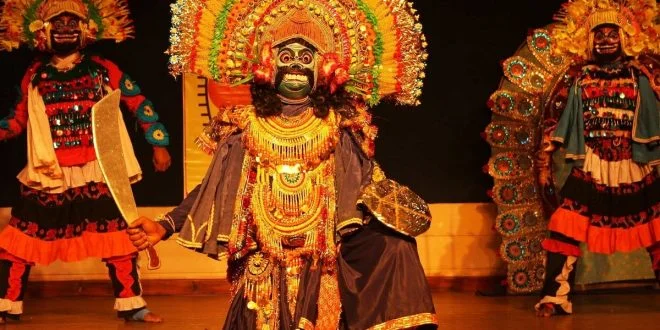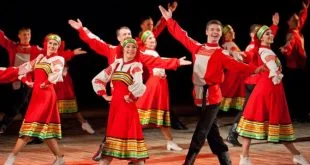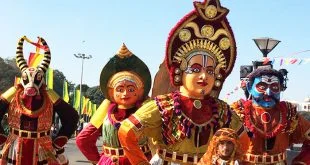Bidesiya Folk Dance
Bidesiya Folk Dance is a traditional dance form originating from the regions of Bihar, India. It holds deep cultural and historical significance, reflecting the local identity, rituals, and celebrations of the community. This vibrant dance is characterized by intricate footwork, distinctive gestures, and traditional costumes, all accompanied by rhythmic folk music. Over time, Bidesiya Folk Dance has evolved, adapting to modern entertainment while facing challenges in preserving its authentic heritage.
Origin and Historical Significance of Bidesiya Folk Dance
Bidesiya Folk Dance, deeply rooted in the cultural heritage of Bihar, India, holds a captivating historical significance that reflects the region’s rich traditions and social practices. The term “Bidesiya” itself alludes to the dance form’s essence, as it translates to “foreigner” in English. This dance, originating from the rural landscapes of Bihar, has been a dynamic medium for the expression of the local community’s experiences, emotions, and stories throughout the ages.
The historical roots of Bidesiya Folk Dance can be traced back to ancient times when it was often performed during various occasions, ranging from weddings and harvest festivals to religious ceremonies and community gatherings. As an integral part of the region’s cultural fabric, the dance encapsulated the aspirations, struggles, and joys of the people, thus becoming a vivid narrative of their lives.
Bidesiya Folk Dance also played a pivotal role in cultural exchanges, serving as a means of communication between different communities and regions. Through its captivating movements and expressive gestures, it conveyed tales of love, separation, migration, and unity. These stories were passed down from one generation to another, contributing to the preservation of historical and social knowledge.
Furthermore, the dance’s historical significance lies in its ability to capture the essence of Bihar’s rural life and its connection to the land. The choreography often imitates agricultural activities, like sowing seeds and reaping crops, mirroring the agrarian lifestyle of the people. Additionally, Bidesiya’s incorporation of rituals and traditional practices underlines its role as a carrier of the region’s cultural heritage.
In conclusion, the Bidesiya Folk Dance stands as a testament to Bihar’s historical and cultural tapestry. Through its evocative performances, it has transmitted stories, emotions, and traditions across generations, while acting as a bridge between different communities. As time progresses, this dance form continues to remind us of its enduring significance in shaping the identity and narratives of the region’s people.
Cultural Symbolism and Attire in Bidesiya Folk Dance
Bidesiya Folk Dance, beyond its captivating movements and rhythmic cadence, is a visual representation of cultural symbolism and heritage through its distinctive attire. The costumes worn by the performers are not merely garments but integral elements that convey deep-rooted meanings and reflections of the community’s identity and values.
The attire in Bidesiya Folk Dance serves as a canvas upon which the stories and traditions of the region are painted. The choice of clothing, colors, and embellishments is a deliberate effort to encapsulate the essence of Bihar’s cultural diversity. Bright and vibrant hues dominate the costumes, reflecting the vivacity and exuberance of the people and their celebrations. These colors also embody the various emotions and narratives that the dance aims to convey – from the warmth of love to the fervor of festivity.
The attire’s intricate details hold a treasure trove of cultural symbolism. Embroidery, beadwork, and mirror embellishments often adorning the costumes tell tales of artistic prowess, community heritage, and historical legacies. These intricate decorations are not only an aesthetic delight but also represent the artisanal skills that have been passed down through generations, preserving the cultural threads of the past.
Moreover, the attire in Bidesiya Folk Dance serves as a link to the rural way of life. Traditional jewelry, headgear, and accessories worn by both male and female performers echo the agrarian traditions and practices that define Bihar’s landscape. These elements often mimic nature – with motifs of flowers, leaves, and animals – further emphasizing the dance’s connection to the land and its surroundings.
The costumes also play a pivotal role in distinguishing various characters and narratives portrayed within the dance. Whether it’s depicting mythical stories, historical events, or celebratory moments, the attire aids in creating a visual narrative that complements the dance movements and adds depth to the overall performance.
In essence, the attire in Bidesiya Folk Dance is not merely a superficial adornment but a vessel carrying the weight of cultural significance, heritage, and artistic expression. It encapsulates the stories, emotions, and values of the community, forming an integral part of the dance’s portrayal of Bihar’s diverse and vibrant culture.
Costumes and Attire in Bidesiya Folk Dance
In the realm of Bidesiya Folk Dance, the costumes and attire worn by the performers are not just garments; they are integral components that amplify the dance’s cultural significance, visual splendor, and narrative depth. These meticulously crafted costumes not only adorn the dancers but also encapsulate the essence of the dance form, reflecting the tradition, stories, and heritage of Bihar, India.
The attire in Bidesiya Folk Dance is a fusion of art, history, and symbolism. Each element, from the fabric to the intricate embellishments, carries a purposeful meaning. The choice of materials often reflects the traditional textiles of the region, connecting the dancers to the local craftsmanship and weaving practices that have been prevalent for generations. Rich silks, cottons, and other native fabrics showcase the artistic legacy of the region and the deep-rooted ties to its history.
Colors hold a significant role in Bidesiya costumes, with their vibrancy mirroring the exuberance and liveliness of the dance itself. Vivid shades of red, yellow, green, and blue dominate the costumes, echoing the enthusiasm and celebratory spirit of the performers. These hues not only capture the attention but also evoke a sense of the cultural vibrancy that defines the region’s festivals and rituals.
Embellishments such as intricate embroidery, mirror work, and bead detailing transform the costumes into visual narratives. These artistic additions narrate stories, myths, and local legends through their designs, thereby connecting the dancers and the audience to the historical and cultural tales of Bihar. Moreover, the costumes often feature patterns and motifs inspired by nature, echoing the agrarian roots and the deep connection to the land.
The attire in Bidesiya Folk Dance is also indicative of the social and gender dynamics of the community. Female performers often wear vibrant saris adorned with traditional jewelry, while male performers sport dhotis, kurtas, and turbans that reflect the masculine aesthetics of the region. These distinctions provide insight into the societal roles and cultural norms prevalent in Bihar.
In conclusion, the costumes and attire in Bidesiya Folk Dance are a harmonious blend of aesthetics, heritage, and storytelling. Through their colors, fabrics, and embellishments, they weave a tapestry of tradition and culture that enriches the dance’s visual appeal and cultural significance. The attire encapsulates the ethos of Bihar, making it an integral aspect of the Bidesiya Folk Dance experience.
Musical Accompaniment and Rhythms in Bidesiya Folk Dance
At the heart of the captivating Bidesiya Folk Dance lies the inseparable bond between movement and music. The dance is brought to life through its intricate rhythms and melodic accompaniments, which infuse the performances with energy, emotion, and cultural depth. The musical elements that accompany Bidesiya Folk Dance play a pivotal role in enhancing the overall experience and connecting the dancers and audience to the soul of Bihar’s traditional heritage.
The rhythmic patterns that underpin Bidesiya music are reminiscent of the region’s heartbeat, pulsating with the energy and vitality of the local community. Traditional instruments such as the dholak (double-headed drum), harmonium, and manjira (hand cymbals) provide the backbone for the dance’s rhythm. The dynamic interplay between these instruments forms a canvas upon which the dancers weave their movements, creating a seamless fusion of auditory and visual expressions.
The melodies and tunes in Bidesiya music are carefully curated to resonate with the emotions and narratives of the dance. These melodies often carry echoes of the past, echoing the folk tales, stories, and cultural memories of Bihar. The music’s ability to transition between melancholic and jubilant tones mirrors the range of emotions that the dance seeks to convey – from tales of separation and longing to moments of celebration and unity.
The rhythmic footwork of the dancers synchronizes harmoniously with the musical beats, creating a symphony of movement and sound. The dancers’ steps, claps, and gestures not only embody the music’s rhythms but also amplify their emotional impact. This synchronized dance-music relationship is a hallmark of Bidesiya, adding layers of complexity and depth to the performances.
Moreover, the call-and-response patterns in Bidesiya music engage the audience in a shared experience, making them an active part of the performance. This participatory nature enhances the sense of community and connects individuals to their cultural heritage on a profound level.
In essence, the musical accompaniment and rhythms in Bidesiya Folk Dance serve as a bridge between the past and the present, seamlessly merging tradition with contemporary expression. They infuse the dance with life, emotion, and historical resonance, making Bidesiya an immersive and enriching cultural experience that captures the essence of Bihar’s folk traditions.
Dance Movements and Techniques in Bidesiya Folk Dance
Bidesiya Folk Dance is characterized by its dynamic and expressive dance movements, which form the very essence of this captivating traditional art form. Rooted in the cultural tapestry of Bihar, India, the dance’s intricate techniques and fluid motions create a visual symphony that resonates with the region’s heritage and emotions.
The dance movements in Bidesiya are a reflection of the stories, myths, and daily experiences of the community. From graceful hand gestures that convey emotions to elaborate footwork that mirrors the rhythm of life, each movement serves as a brushstroke on the canvas of this vibrant dance form. The performers utilize their bodies as instruments of expression, translating the essence of their culture into a language of motion.
One of the defining aspects of Bidesiya is its seamless fusion of storytelling and dance. Performers often portray narratives through their movements, whether it’s depicting tales of love, separation, or celebrations. The dance becomes a living, breathing narrative, with each step and gesture carrying the weight of cultural significance and historical resonance.
Intricate footwork is a hallmark of Bidesiya Folk Dance, with the dancers’ feet weaving patterns that mirror the rhythms of the accompanying music. The rhythmic footwork, often accompanied by ankle bells, adds a percussive element to the performance, enhancing the overall auditory and visual experience. The footwork is not only technically challenging but also emotionally evocative, allowing the dancers to communicate a wide range of feelings through their steps.
Fluidity and grace are central to Bidesiya’s dance techniques. The performers’ movements are characterized by a sense of effortlessness, with transitions between poses and gestures executed seamlessly. These techniques not only showcase the dancers’ skill and training but also embody the beauty and elegance that define the region’s cultural aesthetics.
Hand gestures, facial expressions, and body postures are meticulously choreographed to convey emotions and narratives. Performers use mudras (hand gestures) to communicate various feelings, adding depth and nuance to the dance’s storytelling. These gestures, along with facial expressions, serve as windows into the characters and emotions being portrayed, enabling the audience to connect on a profound level.
In essence, the dance movements and techniques in Bidesiya Folk Dance are a harmonious blend of technical prowess and cultural storytelling. They are the means through which the performers breathe life into the dance, allowing the audience to witness the rich tapestry of Bihar’s traditions, emotions, and history unfold before their eyes.
Modern Adaptations and Challenges in Bidesiya Folk Dance
Bidesiya Folk Dance, while deeply rooted in tradition and history, has not remained immune to the currents of modernity and the challenges that come with it. As the world evolves, this traditional dance form from Bihar, India, faces both opportunities for adaptation and the imperative to navigate through a myriad of obstacles in order to preserve its authenticity and cultural relevance.
Modern adaptations of Bidesiya Folk Dance have emerged as artists and performers seek to bridge the gap between tradition and contemporary expression. These adaptations often entail fusions with other dance forms or incorporating modern themes and narratives while retaining the core essence of Bidesiya. This evolution has introduced the dance to new audiences and breathed fresh life into its performances.
Furthermore, technological advancements have enabled Bidesiya Folk Dance to reach global platforms. Through digital media and online platforms, performances can now transcend geographical boundaries, showcasing the beauty and diversity of this traditional art form to a broader audience. This modern accessibility contributes to the dance’s visibility and recognition on a global scale.
However, with the prospect of modernization come significant challenges. One of the foremost challenges is maintaining the authenticity and cultural integrity of Bidesiya Folk Dance amidst the influences of popular culture and contemporary entertainment. Striking a balance between innovation and the preservation of traditional techniques, storytelling, and aesthetics is a delicate endeavor that requires careful consideration.
Another challenge lies in the passing down of knowledge and skills to younger generations. In a rapidly changing world, traditional art forms like Bidesiya face the risk of losing skilled practitioners and the expertise required to perform the dance in its true form. Encouraging and engaging younger individuals to learn and carry forward the dance’s legacy is a crucial step towards its continuity.
Furthermore, the commercialization of Bidesiya for entertainment purposes can sometimes dilute its cultural depth and significance. Stripping away the dance’s authenticity for commercial gain can distort its essence and misrepresent its true cultural narratives.
In conclusion, the modern adaptations and challenges in Bidesiya Folk Dance present a complex interplay between preserving tradition and embracing innovation. Navigating through these challenges while upholding the authenticity and cultural heritage of the dance is a testament to the commitment and dedication of those who endeavor to safeguard this cherished art form for generations to come.
Gallery
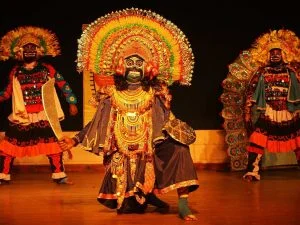
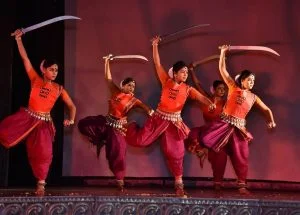



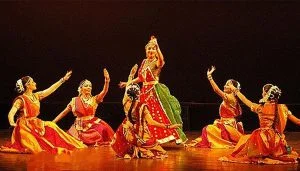
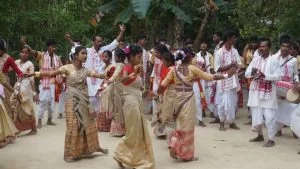
Videos
https://www.youtube.com/watch?v=NE0KTCj5tSA
Frequently asked questions about Bidesiya Folk Dance
What is Bidesiya Folk Dance?
Bidesiya Folk Dance is a traditional dance form originating from Bihar, India. It reflects the region’s culture, history, and stories through intricate movements, vibrant costumes, and rhythmic music.
What is the cultural significance of Bidesiya Folk Dance?
Bidesiya holds deep cultural significance as it reflects the community’s identity, rituals, and celebrations. It conveys narratives, emotions, and traditional values, acting as a visual representation of Bihar’s heritage.
What are the key elements of Bidesiya dance movements?
Bidesiya dance is known for its dynamic footwork, expressive hand gestures (mudras), and graceful body postures. These movements convey stories and emotions, often inspired by rural life and local myths.
ow does Bidesiya Folk Dance adapt to modern times?
Bidesiya has adapted to modernity by incorporating contemporary themes, fusion with other dance forms, and utilizing digital platforms to reach wider audiences. This adaptation helps preserve its relevance and introduce it to new generations.
What challenges does Bidesiya Folk Dance face today?
Bidesiya faces challenges such as maintaining authenticity in a changing world, passing down skills to younger generations, and avoiding commercialization that might dilute its cultural depth. Balancing tradition with modernity is a key challenge.
 FolkDanceWorld.Com International Folk Dances
FolkDanceWorld.Com International Folk Dances
